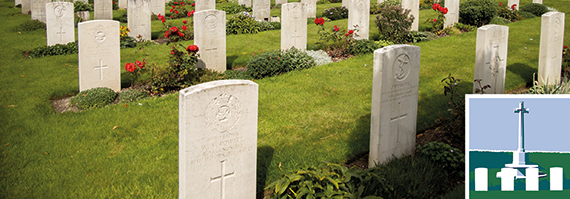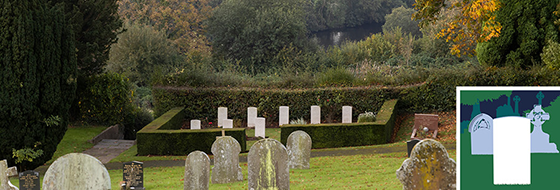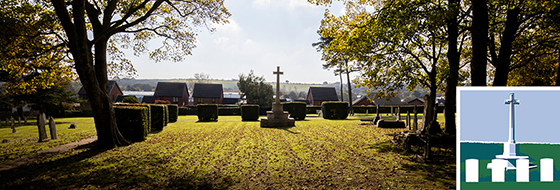Bristol (Arnos Vale) Cemetery
This beautiful example of a grand Victorian garden cemetery is where the CWGC commemorates more war dead than anywhere else in Bristol. Many were buried by their next of kin, but others are far from home indeed.
![]()
During both wars, there were a number of military hospitals in Bristol and the city was the depot of the Gloucestershire Regiment. During the Second World War there were also a number of Royal Air Force stations and prisoner of war camps in the area. Today, the CWGC commemorates over 570 Commonwealth servicemen and women of the two world wars within Arnos Vale War Cemetery.
Find out more
During both world wars, Britain was a centre for the medical care of men and women serving in the armed forces. Thousands of hospitals located across the country were used to treat service personnel who were wounded, fell victim to disease, or were injured in accidents at home or overseas.
The first hospital trains arrived in Bristol in September 1914, carrying 120 soldiers wounded in the Battle of Mons in France. Over the course of the war, trains and hospital ships would bring tens of thousands of military patients to the city’s hospitals, now under military medical command. 2nd Southern General Hospital (SGH) began in the newest wing of the Bristol Royal Infirmary, but soon expanded into many other buildings around the city. By the end of the war, 2nd SGH had treated almost 89,000 servicemen. Most recovered; some were buried in other parts of the UK by their families, and some were laid to rest in Bristol cemeteries like Arnos Vale.

Patients and nurses at 2nd Southern General Hospital, Southmead, during the First World War. North Bristol NHT
Some 360 men and women of Commonwealth forces who died while serving during the First World War are buried or commemorated in this cemetery. The names of some 240 of these are inscribed on the memorial in “Soldiers’ Corner”, the war graves plot near the main entrance. In 2018 the CWGC’s expert stonemasons restored the original flat grave markers in this plot and created 40 new ones to replace those that were missing or beyond repair. Two thirds of the cemetery’s First World War service burials are in this plot and include men of Australian, British, Canadian and South African units.
The rest of our war graves are scattered throughout the cemetery in private plots. Royal Naval Bandsman William Nevin of Bristol was the first serviceman to be buried here after war was declared – he died just 10 days after 4 August 1914. His family laid him to rest in Arnos Vale under a marble cross they chose and, like many families in Britain, didn’t change it to a CWGC headstone when this was offered after the war.
During the Second World War, Bristol was once again the site of numerous military hospitals and convalescent homes and a number of Royal Air Force stations and prisoner of war camps were located nearby. As during the First World War, families in the UK could bury their loved ones themselves if they died in the UK, and most of Arnos Vale’s Second World War servicemen and women are scattered throughout the cemetery.
Follow the cemetery road into the upper cemetery and you will find the CWGC’s Cross of Sacrifice for Arnos Vale. Next to it is “Sailors’ Corner”, a small plot set aside for naval burials, many from a war-time naval hospital 5 miles to the south at Barrow Gurney. Thirty-nine of the cemetery’s 150 Second World War dead are here, including a 22-year-old Sub-Lieutenant Brown from the small town of Carterton in New Zealand. A very high proportion of New Zealand’s volunteers for sea service were allocated to the Royal Navy’s Fleet Air Arm, John Atkinson Brown among them. He was killed when his plane crashed into the Bristol Channel in August 1943. In August 1944 his brother George would also die in service, on a bombing mission to occupied France; he has no known grave and is named on CWGC’s Runnymede Memorial in Surrey.
Between the two world wars, cremation became more widely accepted in the UK, and the first crematorium in the West of England opened in Arnos Vale Cemetery. The names of Second World War servicemen and women cremated here are inscribed on the CWGC’s cremation memorial, to the left of the Non-Conformist Chapel, near the café.
Today, the CWGC commemorates over 570 Commonwealth servicemen and women of the two world wars within Arnos Vale Cemetery. In the Roman Catholic cemetery next door there are more than 60 more. Across both cemeteries we also care for Belgian, Norwegian, Polish and Portuguese war graves.
Come for a woodland walk or wildlife spotting; keep an eye out for a war grave.
Visit Bristol (Arnos) Vale
The cemetery is on the Bath Road, about a mile from Temple Meads Railway station. Before visiting we recommend you visit:
The website of the Site Authority

Amongst the many thousands of civilian burials here are 254 Commonwealth War Graves, 158 from the First World War and 96 from the Second.
Gloucester Old Cemetery
Opened in 1859, this is the final resting place of over 700 Commonwealth and Allied servicemen and women of the two world wars.
Cardiff Cathays Cemetery
Visit the largest group of war graves in this part of Mid Wales. Thirteen servicemen of the First World War and eleven of the Second lie here, most of them under the familiar CWGC pattern headstone.
Brecon Cemetery
Owned by the MOD but cared for by the CWGC, come and visit a century’s graves of men of the army, navy and air force. Forty are First World War graves, while 33 were buried here between 1939-1947.
Pembroke Dock Military Cemetery









